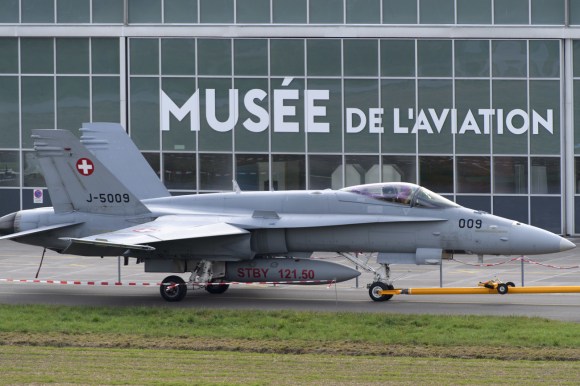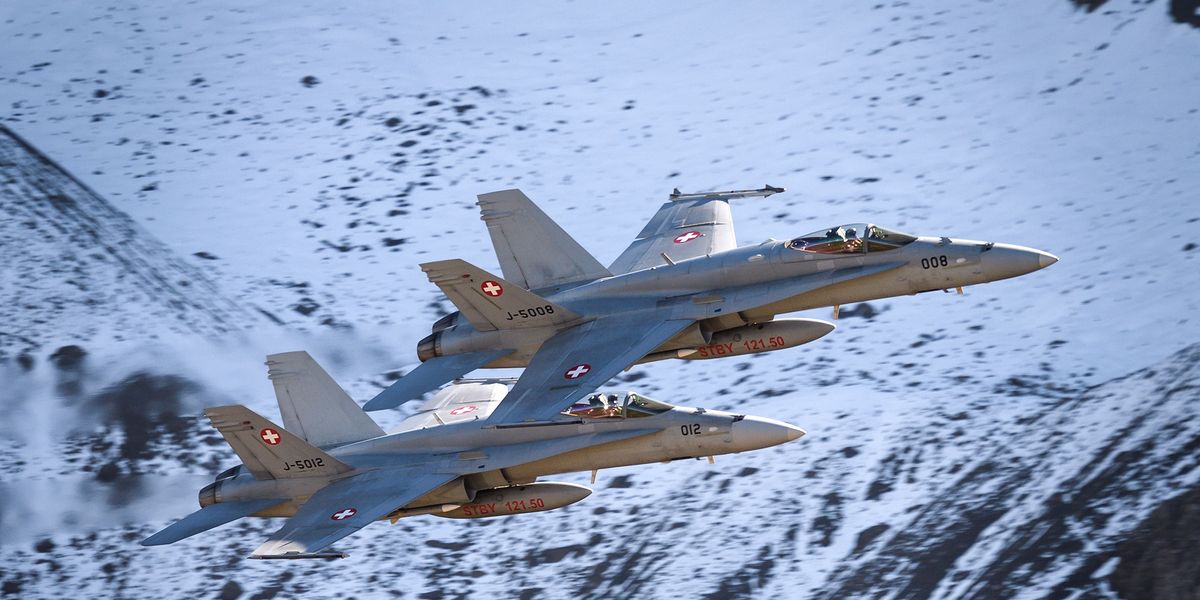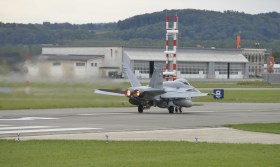Fighters: Switzerland often pays more than other countries
An FA-18 of the Swiss Army Air Force taking off from Payerne airfield. Keystone / Christian Brun
The Confederation tends to pay a high price to acquire fighter planes. For example, it has spent almost the same amount as Finland on the purchase of its F / A-18s, for half the aircraft. But international comparisons come up against a pitfall: the exact contents of the purchase packages are almost always unknown.
This content was published on September 01, 2020 - 10:34September 01, 2020 - 10:34 Pauline Turuban
During the votes of September 27, the Swiss will have to
say whether or not they accept the acquisition of new combat aircraft , for which the Confederation provides a maximum envelope of 6 billion francs. The stakes of the poll are detailed in the article below.
More

The fate of the new fighter plane is at the ballot box
On September 27, the Swiss will say whether they want or a new fighter plane.
Is the Swiss fleet of fighter jets “oversized”? "Luxurious", the expense planned to renew it? Swissinfo.ch took an interest in the size of fleets, fighter jet replacement projects and the budgets allocated to them in other countries to shed light on these questions.
Does Switzerland have a lot of fighter jets?
The report
World Air Forces in 2020 considers the Swiss fleet comprises 46 aircraft active combat, which would make it the absolute number in 43 th World. If we take into account only the 30 F / A-18s and exclude the F-5 Tiger - which are only used to "unload the F / A-18s of secondary tasks" according to the armée- it down to the 51 th spot.
However, if the size of the Swiss airspace is included in the equation, Switzerland joins the small group of countries with the most aircraft in relation to their territory. Switzerland, for example, overtakes Austria, Sweden and Finland, European countries which, like it, are neutral and partners of NATO without being members of it.
External content
Excessive for antimilitarists, necessary for defense circles
Is it a lot? The interpretation of the numbers depends on which side you are on. In a
position paper , the Socialist Party (PS, left) considers that “the current Swiss air forces are completely oversized in international comparison”. In favor of extending the lifespan of the current F / A-18s, the PS stresses that Switzerland has more fighter jets than twenty European countries, and that 12 do not even have any.
"Switzerland needs 8 to 12 light planes for the air police, but no more," adds Lewin Lempert, political secretary at the Groupement pour une Suisse sans anarmie (GSsA) - the anti-militarist movement behind the opposition referendum
.
For his part Alexandre Vautravers, coordinator of the Master in security at the University of Geneva, considers "intellectually fallacious" to say that Switzerland has too many planes. The GSsA "lacks information on strategic realities," the military specialist told swissinfo.ch.
One of the arguments put forward by the left is that states which do not have fighter jets ensure the security of their airspace with cheaper surveillance planes and helicopters - this is the case of Ireland and of North Macedonia, or buy the security of their airspace from NATO, like the three Baltic States or Iceland.
Alexandre Vautravers retorts that most of these countries do not have fighter planes due to lack of resources. And that recourse to a NATO mission to ensure their air safety, "far from being free", requires counterparts. These countries must for example "send troops everywhere when necessary".
RTS explored the differences between Swiss and Austrian aviation safety strategies in a long format to read
here .
Does Switzerland pay more for its fighter jets?
To acquire its 34 F / A-18s, Switzerland has spent "nearly 3.5 billion francs, or a little more than 4.1 billion after adjustment for inflation," says Armasuisse spokeswoman Jacqueline Stampfli. Armasuisse estimates the operating costs at double the acquisition costs. We can deduce that the fleet will have cost at least 12 billion during its thirty years of life.
In Finland (the only one of five European countries contacted to have provided this information to swissinfo.ch), the decision to purchase the 64 F / A-18s was taken in 1992. The acquisition costs amounted to around 3,1 billion euros, said Colonel Juha-Pekka Keränen, director of the fleet replacement program in the Finnish Air Force.
Two upgrades were made for around 1 billion euros, to which must be added operating and maintenance costs "less than 200 million euros per year", he added. This means that Finland has paid almost the same price as Switzerland, but for twice as many planes.
Several cheaper purchasing projects abroad
And in the future, Switzerland always seems ready to put more resources into the renewal of its fleet than other countries. The credit capped at 6 billion should allow the acquisition of 30 to 40 new devices, at a unit price of 150 to 200 million francs, according to Jacqueline Stampfli d'Armasuisse - the exact number will depend on the model chosen.
Several European countries have announced their intention to acquire F-35s, one of the models envisaged to replace the Swiss fleet, for a price lower than that envisaged by the Confederation. Belgium, for example, plans to acquire 34 F-35s for around 4 billion euros (4.3 billion francs, or a unit price of 126.5 million), reported the
Neue Zürcher Zeitung at the end of 2018. “ This price also includes the training of pilots, logistics buildings such as hangars and maintenance of fighter planes until 2030, ”the article said.
We can also mention Denmark which, according to
Defense News, plans to buy 27 F-35s for 2.9 billion francs (or 107 million by plane); Poland, which signed a contract at the start of the year for 32 F-35s at a unit price of 144 million dollars (131 million francs) according to
Spiegel; or Greece, where the purchase project concerns 24 F-35 for 3 billion dollars (125 million by plane). According to
Keep Talking Greece , the price also includes infrastructure, the armament of 82 F-16s and the possible purchase of warships and war material.
To replace its current fleet of 62 aircraft, Finland is planning a larger acquisition budget than Switzerland: a maximum of 10 billion euros (just under 11 billion Swiss francs) could be devoted to it, 'after Colonel Keränen.
The big secret of the contents of purchase packages
Military experts warn, however, against conclusions they consider simplistic. During a press conference in the spring, Christian Catrina, then delegate of the head of the Department of Defense (DDPS) for the renewal of airspace protection means, stressed that it was not relevant to compare acquisition costs in Switzerland with those in other countries.During a transaction, a country can opt, in addition to the devices themselves, for a set of services (armament, logistics, specific equipment, training and evaluation systems, etc.) which in some cases represent a significant portion. of the final price. However, the detailed content of purchase packages is generally ignored, this information being as confidential as it is strategic.
The comparison with Finland illustrates this. According to the Finnish Air Force, the acquisition costs of the F / A-18s included "spare parts, aircraft maintenance and operating manuals, software support, training and training equipment. , deliveries and project management ”.
But, notes Alexandre Vautravers, "in Finland, major periodic maintenance must be done in the United States because there is no local capacity" [bullshit]. While Switzerland has chosen to acquire all the licenses so that the RUAG company is empowered to ensure itself the maintenance of the planes, explains the specialist in defense questions.
According to the expert, if the purchase of licenses is not the most visible part of an acquisition, "it can represent a much better investment in the long term" because "what we do not pay in licenses, we pay it elsewhere, ”he summarizes. The purchase package for the next Finnish fleet will also contain more services than the previous one.
He adds that the political dimension is another factor likely to vary acquisition prices from one country to another. An exporting country may make a commercial gesture or grant benefits in kind, depending on the importance it places on its relationship with the purchasing country. So many issues that will also be decisive when choosing an aircraft model if the people say yes on September 27.






